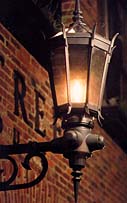Natural Gas - The Blue Flame
 It is colorless, shapeless, and in its pure form, odorless. For many years, it was discarded as worthless. Even today, some countries (although not the United States) still get rid of it by burning it in giant flares, so large they can be seen from the Space Shuttle. Yet, it is one of the most valuable fuels we have. Natural gas is made up mainly of a chemical called methane, a simple, compound that has a carbon atom surrounded by four hydrogen atoms. Methane is highly flammable and burns almost completely. There is no ash and very little air pollution.
It is colorless, shapeless, and in its pure form, odorless. For many years, it was discarded as worthless. Even today, some countries (although not the United States) still get rid of it by burning it in giant flares, so large they can be seen from the Space Shuttle. Yet, it is one of the most valuable fuels we have. Natural gas is made up mainly of a chemical called methane, a simple, compound that has a carbon atom surrounded by four hydrogen atoms. Methane is highly flammable and burns almost completely. There is no ash and very little air pollution.
Natural gas provides one-fifth of all the energy used in the United States. It is especially important in homes, where it supplies nearly half of all the energy used for cooking, heating, and for fueling other types of home appliances. Because natural gas has no odor, gas companies add a chemical to it that smells a little like rotten eggs. The odor makes it easy to smell if there is a gas leak in your house.
The United States has a lot of natural gas, enough to last for at least another 60 years and probably a lot longer. Our neighbor to the north, Canada, also has a lot of gas, and some gas pipelines that begin in Canada run into the United States. The United States is looking for more ways to use gas, largely because it is easy to pipe from one location to another and because it burns very cleanly. More and more, we are using gas in power plants to generate electricity. Factories are using more gas, both as a fuel and as an ingredient for a variety of chemicals. While natural gas is plentiful, there is still some uncertainty about how much it will cost to get it out of the ground in the future. Like oil, there is 'easy' gas that can be produced from underground formations, and there is gas that is not so easy. If we can find better and cheaper ways to find more of the 'easy' gas and produce some of the more difficult gas, we can rely increasingly on natural gas in the future.
Fact Credit
DOE Department of Energy


